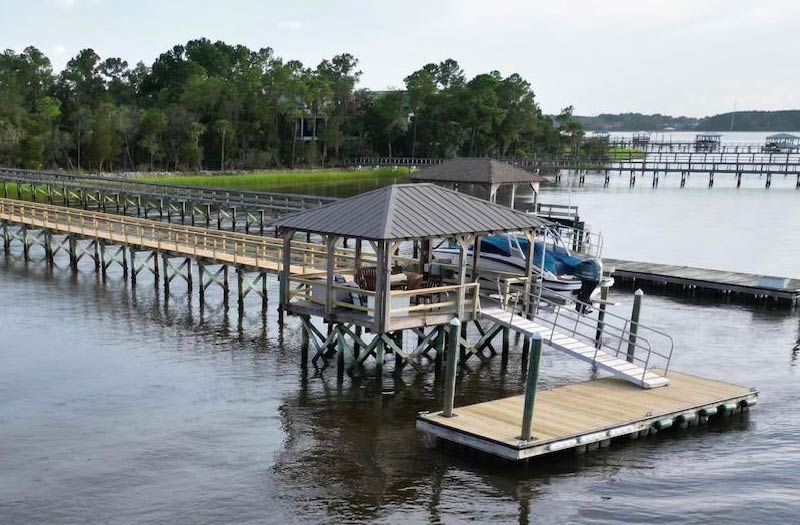Eco-Friendly Dock Construction: Sustainable Waterfront

Eco-friendly dock construction provides sustainable solutions for waterfront properties by utilizing materials and techniques that minimize environmental impact. This article explores how dock construction can align with environmental goals, offering practical insights and new perspectives on building eco-friendly docks.
Key Takeaway
Building an eco-friendly dock involves using sustainable materials, innovative design techniques, and proper maintenance to ensure a minimal ecological footprint. Key points include: - Sustainable Materials: Using wood, aluminum, recycled plastics, and composite materials. - Design Techniques: Focusing on low-impact installation and preservation of natural habitats. - Maintenance: Regular upkeep to prolong the life of the dock and reduce environmental strain.
Benefits of Eco-Friendly Dock Construction
Choosing to build an eco-friendly dock offers numerous benefits that extend beyond the immediate environment. These advantages include:
- Reduced Environmental Impact: Sustainable materials and mindful construction practices help protect aquatic ecosystems and surrounding wildlife.
- Longevity and Durability: Eco-friendly materials are often more durable, reducing the need for frequent repairs and replacements.
- Cost Savings: Over time, the reduced maintenance and longevity of eco-friendly docks can result in considerable cost savings.
- Regulatory Compliance: Many regions have regulations aimed at protecting water bodies, and eco-friendly docks often meet or exceed these requirements.
- Increased Property Value: Environmentally conscious homeowners are increasingly valuing sustainable features, which can enhance property value.
- Sustainable Dock Construction Materials: An Overview
- Sustainable Materials for Marine Construction: A Review
- Sustainable Dock Construction: Materials and Technologies
Wood
Wood has long been a staple in dock construction, but not all wood is created equal. Using sustainably sourced wood can make a significant difference.
Type of Wood Benefits Environmental Impact
- Cedar Naturally resistant to rot and pests Low if sustainably sourced
- Teak Extremely durable in wet conditions High if not certified by sustainable forestry programs
- Mahogany Strong and aesthetically pleasing Medium, depends on sourcing practices
Composite Materials
Composite materials, which blend recycled plastics and wood fibers, offer an eco-friendly alternative to traditional wood docks.
Advantages of Composite Materials: - Durability: High resistance to water, pests, and UV damage. - Low Maintenance: Requires minimal upkeep compared to natural wood. - Eco-Friendly: Made from recycled materials, reducing waste.
Aluminum
Aluminum is another excellent material for eco-friendly docks due to its durability and recyclability. Unlike treated wood, aluminum does not release harmful chemicals into the water.
Innovative Design Techniques
Low-Impact Installation
Minimizing the environmental impact begins with the installation process. Techniques such as helical piling and floating docks reduce the disturbance of the seabed and surrounding habitats.
Habitat Preservation
Designing docks to coexist with local wildlife is crucial. This includes: - Elevating Docks: Raising the dock above the water to allow sunlight to reach aquatic plants. - Creating Shelters: Incorporating habitats for fish and other marine life into the dock design.
Proper Maintenance for Sustainability
Regular Inspections
Routine inspections help identify potential problems before they become significant issues. This proactive approach includes: - Checking for structural damage. - Monitoring for signs of wear and tear. - Ensuring that no harmful materials are leaching into the water.
Eco-Friendly Cleaning Practices
Using environmentally friendly cleaning products and methods helps maintain the dock without harming the local ecosystem. Avoiding harsh chemicals and opting for biodegradable options are essential steps.
Case Study: Successful Eco-Friendly Dock Projects
Baker Marine Contracting in Charleston, SC
Baker Marine Contracting successfully implemented eco-friendly dock construction techniques in various projects across Charleston. By using sustainably sourced materials and low-impact installation methods, they have set a benchmark for environmentally conscious marine construction.
Project Highlights
- Floating Dock in Beaufort: Utilized recycled composite materials and helical piles to minimize seabed disturbance.
- Residential Dock in Hilton Head: Incorporated aluminum framing and elevated design to protect aquatic plants and animals.
Client Testimonials
- C.M., Charleston: "Hunter managed to keep everything rolling right on schedule with meticulous attention to detail. We felt we could fully trust him with everything."
- S.C., Mt. Pleasant: "Hunter and his crew were very professional and quickly handled my repair job. Quality work and attention to detail."
Eco-Friendly Dock Accessories
Solar Lighting
Adding solar-powered lights to your dock reduces energy consumption and avoids the need for electrical installations that can harm the environment.
Native Vegetation
Planting native vegetation around the dock can help stabilize the shoreline, provide habitat for wildlife, and enhance the dock's aesthetic appeal.
Comparing Traditional vs. Eco-Friendly Dock Construction
Aspect Traditional Dock Construction Eco-Friendly Dock Construction
- Materials Pressure-treated wood, non-recycled metals
- Sustainable wood, recycled composites, aluminum
- Installation Often disturbing to local habitats
- Designed to minimize environmental impact
- Maintenance Frequent, using chemical treatments
- Low-maintenance, eco-friendly cleaning
- Longevity Shorter lifespan due to material degradation
- Longer lifespan with durable materials
- Environmental Impact High, with potential pollution Low, with focus on sustainability
Common Misconceptions
Eco-Friendly Docks are More Expensive
While the initial cost of materials may be higher, the long-term savings from reduced maintenance and greater durability often outweigh the initial investment. Additionally, sustainable materials have become more affordable as demand increases.
Limited Design Options
Eco-friendly materials offer a wide range of design possibilities. Composite materials, for example, come in various colors and textures, allowing for customization that matches traditional wood aesthetics.
The Future of Eco-Friendly Dock Construction
The demand for sustainable construction practices is on the rise, and eco-friendly dock construction is no exception. Technological advancements and increased awareness of environmental issues are driving innovation in this field.
Conclusion
Eco-friendly dock construction is not just a trend; it's a responsible choice for the future of our waterfronts. By using sustainable materials, innovative design techniques, and proper maintenance, we can build docks that are both functional and environmentally friendly. Whether you're considering a new build or upgrading an existing dock, eco-friendly options provide a sustainable solution that benefits both the environment and your property.
Key Takeaways
- Sustainable Materials: Use responsibly sourced wood, recycled composites, and aluminum.
- Low-Impact Design: Focus on habitat preservation and minimal environmental disturbance.
- Proactive Maintenance: Regular inspections and eco-friendly cleaning practices enhance dock longevity.
- Innovative Accessories: Incorporate solar lighting and native vegetation for added sustainability.
- Cost-Effective: Long-term savings from reduced maintenance and increased durability.
For more insights into eco-friendly dock construction and to view our portfolio, visit Baker Marine Contracting today.
By focusing on innovative angles and combining practical tips with real-life case studies, this article provides a fresh perspective on eco-friendly dock construction. It offers new insights for readers looking to make environmentally conscious choices for their waterfront properties.
























































